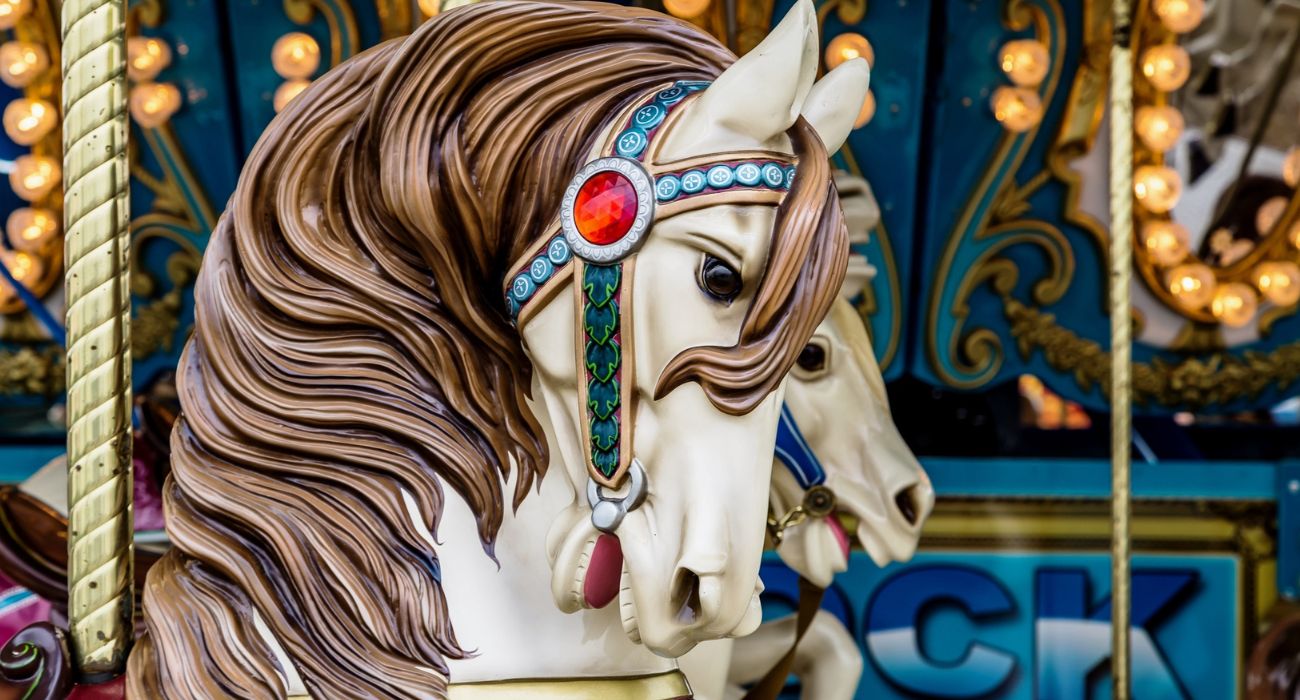Nestled away in a gazebo on the San Diego bayfront, a herd of Texas horses continues its ride — alongside a bear, a lion, a donkey, and other assorted menagerie.
This is not some satellite location of the San Diego Zoo’s, but rather the final resting place of a historic carousel originally featured in Dallas’ own Fair Park.
Built by the famous Charles Looff, the carousel entertained crowds at the Texas State Fair after opening in the early 1900s. There it remained for several decades before being uprooted and shipped to Santa Monica’s Pacific Ocean Park in the 1950s, according to the plaque placed at the carousel.
The 1970s saw the herd of horses and other creatures travel to Spanaway, Washington, before doing a stint in Portland, Oregon, from 1979 to 1991 and enjoying a full restoration in 1992. By 1997, the wandering carousel found its way to Burbank until it was transported to Seaport Village in San Diego in 2004, where it continues to operate.
Although the plaque in Seaport Village claims the Looff Carousel was first placed in Fair Park in 1895, a review of the local papers from the period suggests that crowds at the Texas State Fair had to wait until 1905 for such an attraction.
A New Hampshire paper noted on August 18, 1905, “Mr. Charles Looff, proprietor of a number of the leading amusements at Crescent Park and his son, William, left for Dallas, Tex., Saturday morning, where they are to erect a number of slides, shoots, etc. Mr. Looff and son will be in Dallas until November.”
Once the older and younger Looff reached Dallas, they assembled the carousel to prepare for the State Fair. During a preview of the grounds in early October, a local paper recorded that nearly 4,000 guests toured the grounds and “liberally patronized” the amusements, which included “the revolving horses and other carved animals.”
Looff’s carousel began operating daily before the fair, and the “mammoth Carry-Us-All,” as the papers referred to it, was accompanied by a $3,000 organ that furnished “music of a most artistic and entertaining character to all who take a ride on the beautifully carved and loping horses of this, the latest and most enjoyable merry-go-round that has ever been seen in Dallas.”
On October 17, 1905, Looff reported to R.R. Nelms, treasurer of the Fair Park fund, that the carousel and his other amusements earned $1,122.50 the previous week. The sensational carousel itself “netted $249.30 on Sunday and more than $300 during the week.”
Looff’s carousel figured prominently in advertisements for the State Fair, and the “handsomely carved horses” of the expert woodworker operated “continuously from the opening to the closing hour of the Fair.”
The carousel became a permanent fixture at the Texas State Fair, and years later, people were still enjoying the amusement. Sometime in the 1950s, Looff’s miraculous creation was removed from the park and later replaced by another historic carousel designed by one of his competitors.
Looff himself lived an impressive life. Originally from Schleswig-Holstein in what is now Germany, he immigrated to the United States in 1870 when he was only 18 years old. Having learned the art of woodcarving, he spent several years working as a furniture maker by day while pursuing his passion project by night — carving animals for carousel machines.
The enterprising man built the first several carousels on his own, with his first finding a home on Coney Island in 1876. He was largely responsible for pioneering the now-distinctive animal styles people associate with carousels.
Compared to others, “Looff aspired to a more fanciful design both in his carousels and the buildings which housed them,” according to entertainment historian Tobin Fraley. “Glass jewels and beveled mirrors were added to trappings; leg positions and manes were more animated.”
Looff carved most of his horses based on a picture of George Washington on horseback, depicting them as “jolly, with bulging nostrils to show heavy breathing” and exposed teeth.
In addition to producing the animals and building the machines, Looff was also an amusement park entrepreneur and contributed to the early success of Coney Island before moving to California and founding several parks on the Pacific seaboard.
The tycoon was quite the character, and reports in his later years described his fondness of wrestling with his pet bears. A newspaper suggested in 1911, “When Looff feels the cloying atmosphere of great mental strain he merely goes out in his back yard opens the doors of his menagerie and takes a fall out of his bears.”
“The manufacturer already has … three bears [in] his collection and is now looking for another bruin, one that is really in his class,” the article continues. “He is willing to take anything except a grizzly which has not been fed lately.”
Looff’s eccentric and imaginative mind helped him foster a sense of excitement for riders on his carousels, which have now become highly treasured historical relics, with a single animal fetching thousands of dollars at auction. Chances to enjoy his creations the way they were intended are few and far between.
However, if people find themselves walking along the San Diego Bay, they can still enjoy a rather fast-paced spin on the ancient Texas horses. Despite being 128 years old, the ride remains as enjoyable as ever, transporting riders to a simpler time.






